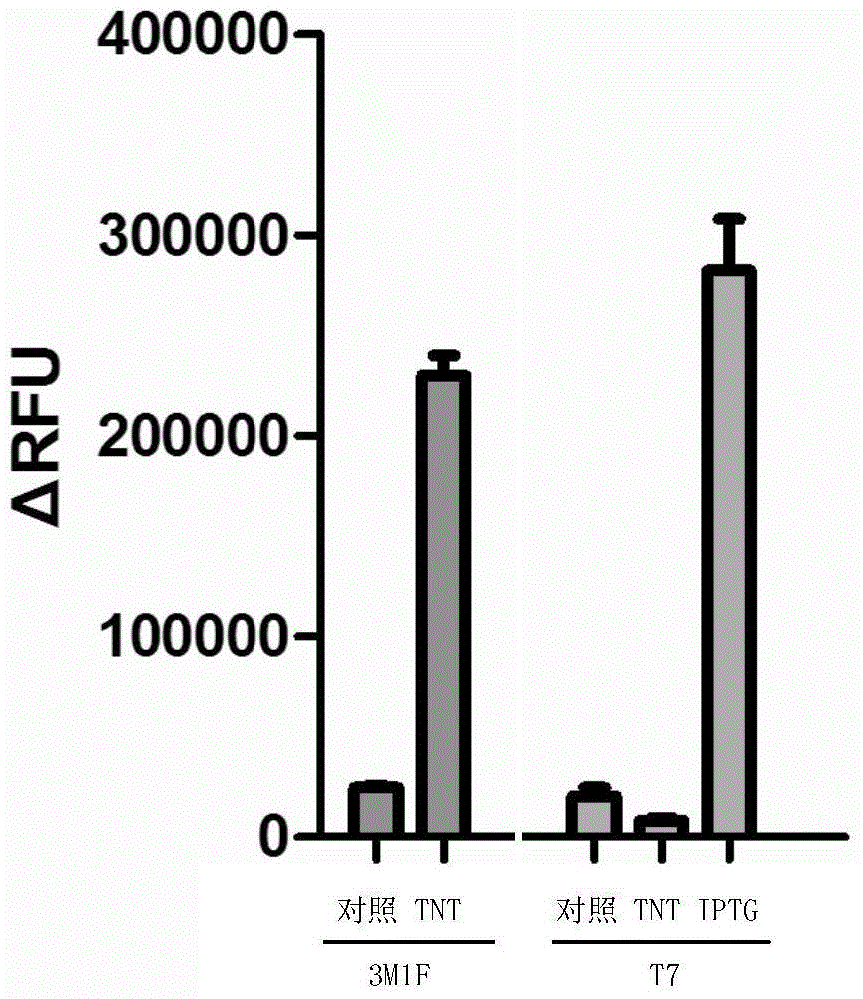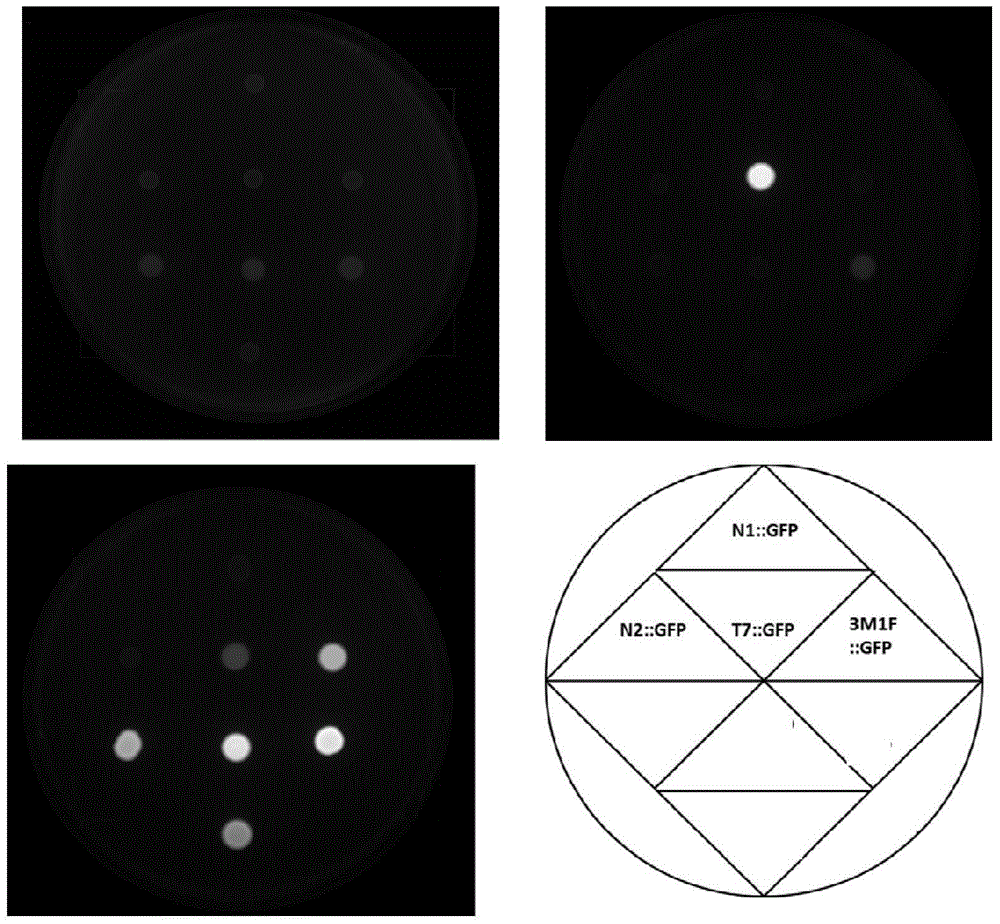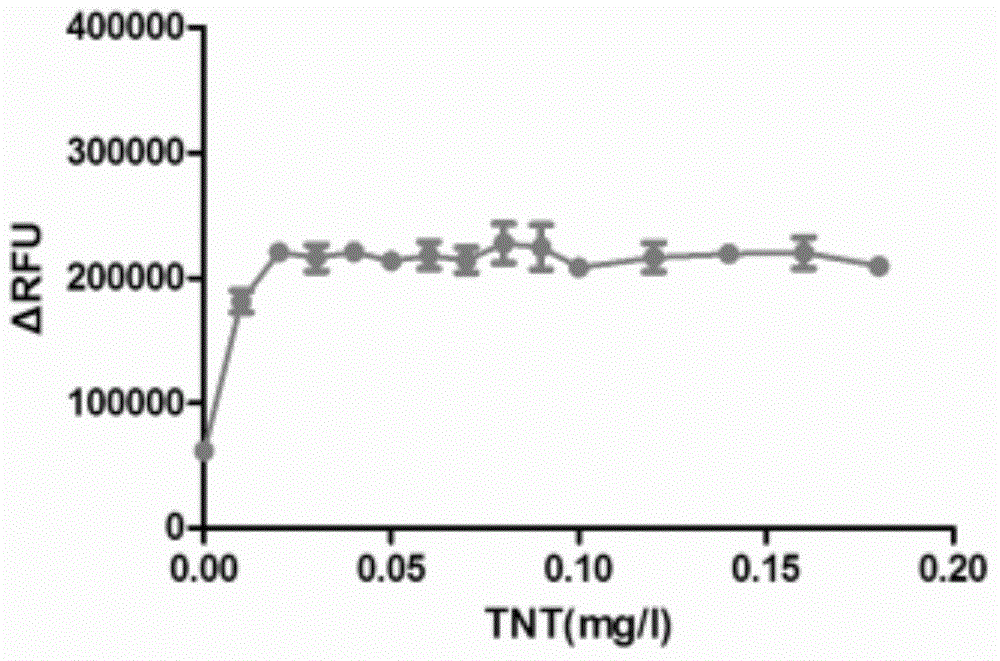Promoter 3M1F and applications thereof
A technology of DNA molecules and sequences, applied in the direction of using vectors to introduce foreign genetic material, DNA/RNA fragments, and microbial measurement/inspection. It can solve the problems of expensive, TNT poisoning, etc., and achieve good component reserves, good specificity and sensitivity. Effect
- Summary
- Abstract
- Description
- Claims
- Application Information
AI Technical Summary
Problems solved by technology
Method used
Image
Examples
Embodiment 1
[0023] Embodiment 1, discovery of promoter sequence
[0024] 1. Extract the chromosome genome of Escherichia coli K-12 MG1655.
[0025] 2. Using the chromosomal genome obtained in step 1 as a template, the NEB Q5 MIX high-fidelity PCR system was used to amplify the promoter element.
[0026] 3. Add dATP to all the amplified products obtained in step 2 respectively through Taq enzyme polymerization reaction to form polyA, and then connect them into vector pMD18-T through DNA ligation operation to obtain recombinant plasmids.
[0027]4. Digest the recombinant plasmid obtained in step 3 with restriction endonucleases Xba I and Bgl II, and recover small fragments.
[0028] 5. Digest the pET24-GFP vector with restriction endonucleases Xba Ⅰ and Bgl Ⅱ to recover the vector skeleton.
[0029] 6. Ligate the small fragment obtained in step 4 with the vector backbone obtained in step 5 to obtain a recombinant plasmid.
[0030] 7. Introduce the recombinant plasmid obtained in step 6 i...
Embodiment 2
[0036] Embodiment 2, the acquisition of recombinant bacteria and control bacteria
[0037] 1. Acquisition of recombinant bacteria
[0038] 1. Synthesize the double-stranded DNA molecule shown in sequence 1 of the sequence listing.
[0039] 2. Double-digest the double-stranded DNA molecule obtained in step 1 with restriction endonucleases BglII and XbaI, and recover the digested product.
[0040] 3. Digest the pET24-GFP vector with restriction endonucleases BglII and XbaI to recover the vector backbone of about 6000 bp.
[0041] 4. Ligate the digested product of step 2 with the vector backbone of step 3 to obtain a recombinant plasmid.
[0042] 5. Introduce the recombinant plasmid obtained in step 4 into Escherichia coli BL21(DE3) to obtain recombinant bacteria.
[0043] Second, the acquisition of control bacteria
[0044] 1. Insert the T7 promoter (the double-stranded DNA molecule shown in Sequence 3 in the Sequence Listing) between the BglII and XbaI restriction sites of ...
Embodiment 3
[0056] Example 3, functional verification of the promoter
[0057] The treatment method of the recombinant bacteria TNT group: inoculate the recombinant bacteria obtained in step 1 of Example 2 into LB liquid medium, and cultivate to OD 600nm When =0.6, add TNT and make its concentration 15mg / L, then 30 ℃, 200rpm shaking culture 12h, draw 200 μ l bacterial fluid to 96 hole polystyrene detection plate (Bio-rad) then, detect in Pekin Elmer 2300Multilablel Reader ( GFP detection conditions are excitation / emission, 485 / 535nm).
[0058] The treatment method of the recombinant bacteria control group: inoculate the recombinant bacteria obtained in step 1 of Example 2 into LB liquid medium, and cultivate to OD 600nm =0.6, then 30°C, 200rpm shaking culture for 12h, then pipette 200 μl of bacterial liquid to a 96-well polystyrene detection plate (Bio-rad), and detect it in Pekin Elmer 2300 Multilablel Reader (GFP detection conditions are excitation / emission, 485 / 535nm).
[0059] The...
PUM
 Login to View More
Login to View More Abstract
Description
Claims
Application Information
 Login to View More
Login to View More - R&D
- Intellectual Property
- Life Sciences
- Materials
- Tech Scout
- Unparalleled Data Quality
- Higher Quality Content
- 60% Fewer Hallucinations
Browse by: Latest US Patents, China's latest patents, Technical Efficacy Thesaurus, Application Domain, Technology Topic, Popular Technical Reports.
© 2025 PatSnap. All rights reserved.Legal|Privacy policy|Modern Slavery Act Transparency Statement|Sitemap|About US| Contact US: help@patsnap.com



